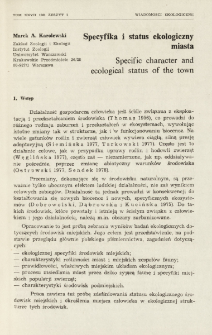- Search in all Repository
- Literature and maps
- Archeology
- Mills database
- Natural sciences
Advanced search
Advanced search
Advanced search
Advanced search
Advanced search

Object
Title: Specyfika i status ekologiczny miasta
Subtitle:
Specific character and ecological status of the town
Contributor:
Polska Akademia Nauk. Komitet Ekologiczny
Publisher:
Place of publishing:
Description:
Pages 3-35 ; 24 cm ; Bibliographical references (pages 34-35) ; Abstract in English
Type of object:
Abstract:
This is an attempt to present results of ecological studies of urban environments. A review of mainly Polish literature is the basis foT presentation of problems concerning: specific ecological character of urban environments, characteristics of town vegetation and municipal fauna communities, regularities of municipal ecological systems, colonization of towns by wild fauna and the specific character of municipal animals populations, characteristics of suburban environments, ecological status of urban environment and the place of man in the ecological structure of these environments.As regards biotic and abiotic conditions urban environments differ basically from natural and other anthropogenic environments and are specific „ecological islands”.Artificial town vegetation — formed from the very beginning — is constantly under the influence of man's activities (Fig. 1), which, amongst other things, is the cause of serious disturbances in the functioning of biotic systems. Isolated municipal greens have various types of vegetation and differ considerably as regards the areas it occupies. The structure and character of vegetation affect strongly the formation of town fauna communities.Town fauna has been studied unevenly and in fragments. Communities of town fauna, and especially the best known town avifauna differ distinctly from wild communities (Table I). With increasing urbanization the number of species decreases at a simultaneous increase in numbers of other populations. In town communities there is ho stability and there are frequent changes in the dominance structure as regards the dominance of one species. Under extreme conditions the number of species and numbers decrease. Quite many populations live in buildings moving towards the centTe where the buildings are close to one another (Table II), whereas other populations leave towns to live in its surroundings.Wild populations colonize in the vicinity of towns because of the attractiveness of this kind of environment. Several populations gradually penetrating the town undergo the synurbization process (Table III) and adapt to life under artificial, much changed conditions.Adaptation of population to specific urban environment is responsible for a number of significant changes in its ecology, biology and ethology, for changes of physiological properties and also perhaps genetic features. Thus separate urban populations are formed which are quite different from populations of the same species (Table IV). Numerous data point also to the simultaneous occurrence in town of wild and typically town population, but the town population colonizes mainly the centre and the wild one is pushed out in the direction of suburbs (Table II).Towns and surrounding areas strongly influence one another. Suburban environments, additonally under the influence of neighbouring natural environments, are very specific both from the point of landscape and ecologically. They are very important as a potential pool of fauna supplying — permanently or periodically — urban environments […]
Relation:
Volume:
Issue:
Start page:
End page:
Detailed Resource Type:
Resource Identifier:
oai:rcin.org.pl:204579 ; ISSN 0013-2969
Source:
MiIZ PAN, call no. P.3259 ; click here to follow the link
Language:
Language of abstract:
Rights:
Creative Commons Attribution BY 3.0 PL license
Terms of use:
Copyright-protected material. [CC BY 3.0 PL] May be used within the scope specified in Creative Commons Attribution BY 3.0 PL license, full text available at: ; -
Digitizing institution:
Museum and Institute of Zoology of the Polish Academy of Sciences
Original in:
Library of the Museum and Institute of Zoology of the Polish Academy of Sciences
Projects co-financed by:
Access:
Object collections:
- Digital Repository of Scientific Institutes > Partners' collections > Museum and Institute of Zoology PAS > Scientific Journals
- Digital Repository of Scientific Institutes > Literature > Journals/Articles
Last modified:
Feb 4, 2025
In our library since:
Aug 9, 2021
Number of object content downloads / hits:
632
All available object's versions:
https://rcin.org.pl./publication/144287
Show description in RDF format:
Show description in RDFa format:
Show description in OAI-PMH format:
| Edition name | Date |
|---|---|
| Z. 1. Specyfika i status ekologiczny miasta / Karolewski M. A. | Feb 4, 2025 |
Objects Similar
Zimny, Henryk (1928– )
Trojan, Przemysław (1929– )
Zimny, Henryk (1928– )
Czechowski, Wojciech (1950– ) Pisarski, Bohdan (1928–1992)
Czechowski, Wojciech (1950– ) Pisarski, Bohdan (1928–1992)
Symonides, Ewa

 INSTYTUT ARCHEOLOGII I ETNOLOGII POLSKIEJ AKADEMII NAUK
INSTYTUT ARCHEOLOGII I ETNOLOGII POLSKIEJ AKADEMII NAUK
 INSTYTUT BADAŃ LITERACKICH POLSKIEJ AKADEMII NAUK
INSTYTUT BADAŃ LITERACKICH POLSKIEJ AKADEMII NAUK
 INSTYTUT BADAWCZY LEŚNICTWA
INSTYTUT BADAWCZY LEŚNICTWA
 INSTYTUT BIOLOGII DOŚWIADCZALNEJ IM. MARCELEGO NENCKIEGO POLSKIEJ AKADEMII NAUK
INSTYTUT BIOLOGII DOŚWIADCZALNEJ IM. MARCELEGO NENCKIEGO POLSKIEJ AKADEMII NAUK
 INSTYTUT BIOLOGII SSAKÓW POLSKIEJ AKADEMII NAUK
INSTYTUT BIOLOGII SSAKÓW POLSKIEJ AKADEMII NAUK
 INSTYTUT CHEMII FIZYCZNEJ PAN
INSTYTUT CHEMII FIZYCZNEJ PAN
 INSTYTUT CHEMII ORGANICZNEJ PAN
INSTYTUT CHEMII ORGANICZNEJ PAN
 INSTYTUT FILOZOFII I SOCJOLOGII PAN
INSTYTUT FILOZOFII I SOCJOLOGII PAN
 INSTYTUT GEOGRAFII I PRZESTRZENNEGO ZAGOSPODAROWANIA PAN
INSTYTUT GEOGRAFII I PRZESTRZENNEGO ZAGOSPODAROWANIA PAN
 INSTYTUT HISTORII im. TADEUSZA MANTEUFFLA POLSKIEJ AKADEMII NAUK
INSTYTUT HISTORII im. TADEUSZA MANTEUFFLA POLSKIEJ AKADEMII NAUK
 INSTYTUT JĘZYKA POLSKIEGO POLSKIEJ AKADEMII NAUK
INSTYTUT JĘZYKA POLSKIEGO POLSKIEJ AKADEMII NAUK
 INSTYTUT MATEMATYCZNY PAN
INSTYTUT MATEMATYCZNY PAN
 INSTYTUT MEDYCYNY DOŚWIADCZALNEJ I KLINICZNEJ IM.MIROSŁAWA MOSSAKOWSKIEGO POLSKIEJ AKADEMII NAUK
INSTYTUT MEDYCYNY DOŚWIADCZALNEJ I KLINICZNEJ IM.MIROSŁAWA MOSSAKOWSKIEGO POLSKIEJ AKADEMII NAUK
 INSTYTUT PODSTAWOWYCH PROBLEMÓW TECHNIKI PAN
INSTYTUT PODSTAWOWYCH PROBLEMÓW TECHNIKI PAN
 INSTYTUT SLAWISTYKI PAN
INSTYTUT SLAWISTYKI PAN
 SIEĆ BADAWCZA ŁUKASIEWICZ - INSTYTUT TECHNOLOGII MATERIAŁÓW ELEKTRONICZNYCH
SIEĆ BADAWCZA ŁUKASIEWICZ - INSTYTUT TECHNOLOGII MATERIAŁÓW ELEKTRONICZNYCH
 MUZEUM I INSTYTUT ZOOLOGII POLSKIEJ AKADEMII NAUK
MUZEUM I INSTYTUT ZOOLOGII POLSKIEJ AKADEMII NAUK
 INSTYTUT BADAŃ SYSTEMOWYCH PAN
INSTYTUT BADAŃ SYSTEMOWYCH PAN
 INSTYTUT BOTANIKI IM. WŁADYSŁAWA SZAFERA POLSKIEJ AKADEMII NAUK
INSTYTUT BOTANIKI IM. WŁADYSŁAWA SZAFERA POLSKIEJ AKADEMII NAUK




































